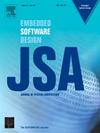TrustDedup: Secure data deduplication for IoT based on end–edge–cloud collaboration
IF 4.1
2区 计算机科学
Q1 COMPUTER SCIENCE, HARDWARE & ARCHITECTURE
引用次数: 0
Abstract
In Internet of Things (IoT)-enabled smart societies, the rapid growth of IoT devices has led to a substantial amount of redundant data stored in the cloud, significantly reducing storage efficiency. Although data deduplication effectively addresses redundancy, it introduces security concerns related to data confidentiality and ownership verification, particularly in semi-trusted cloud environments. Current deduplication methods primarily focus on cloud-only models and fail to accommodate the emerging end–edge–cloud collaborative framework driven by edge computing. To address these challenges, this paper proposes TrustDedup, a secure and efficient deduplication scheme that integrates edge–cloud collaboration and blockchain technology. The proposed scheme employs convergent encryption for secure data deduplication, uses blockchain-based smart contracts for transparent ownership verification, and includes a two-tiered deduplication approach to enhance efficiency and mitigate label inconsistency attacks. Security analyses and experimental results demonstrate that the proposed solution effectively improves deduplication efficiency and ensures robust data security in IoT scenarios.
TrustDedup:基于端到端云协同的物联网安全重复数据删除
在支持物联网(IoT)的智能社会中,物联网设备的快速增长导致大量冗余数据存储在云中,大大降低了存储效率。虽然重复数据删除有效地解决了冗余问题,但它引入了与数据机密性和所有权验证相关的安全问题,特别是在半可信的云环境中。当前的重复数据删除方法主要侧重于纯云模型,无法适应由边缘计算驱动的新兴端到端云协作框架。为了应对这些挑战,本文提出了TrustDedup,这是一种安全高效的重复数据删除方案,集成了边缘云协作和区块链技术。提出的方案采用收敛加密进行安全的数据重复删除,使用基于区块链的智能合约进行透明的所有权验证,并包括两层重复数据删除方法来提高效率并减轻标签不一致攻击。安全性分析和实验结果表明,该方案有效提高了物联网场景下的重复数据删除效率,保证了数据的鲁棒安全性。
本文章由计算机程序翻译,如有差异,请以英文原文为准。
求助全文
约1分钟内获得全文
求助全文
来源期刊

Journal of Systems Architecture
工程技术-计算机:硬件
CiteScore
8.70
自引率
15.60%
发文量
226
审稿时长
46 days
期刊介绍:
The Journal of Systems Architecture: Embedded Software Design (JSA) is a journal covering all design and architectural aspects related to embedded systems and software. It ranges from the microarchitecture level via the system software level up to the application-specific architecture level. Aspects such as real-time systems, operating systems, FPGA programming, programming languages, communications (limited to analysis and the software stack), mobile systems, parallel and distributed architectures as well as additional subjects in the computer and system architecture area will fall within the scope of this journal. Technology will not be a main focus, but its use and relevance to particular designs will be. Case studies are welcome but must contribute more than just a design for a particular piece of software.
Design automation of such systems including methodologies, techniques and tools for their design as well as novel designs of software components fall within the scope of this journal. Novel applications that use embedded systems are also central in this journal. While hardware is not a part of this journal hardware/software co-design methods that consider interplay between software and hardware components with and emphasis on software are also relevant here.
 求助内容:
求助内容: 应助结果提醒方式:
应助结果提醒方式:


